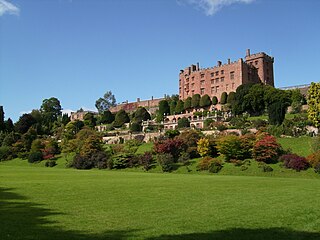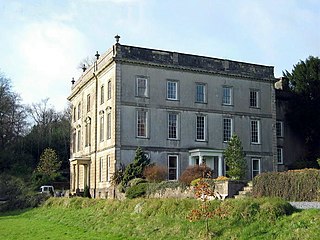
Menai Bridge is a town and community on the Isle of Anglesey in north-west Wales. It overlooks the Menai Strait and lies by the Menai Suspension Bridge, built in 1826 by Thomas Telford, just over the water from Bangor. With a population of 3,376, it is the fifth largest town on the island. The built-up area including Llandegfan had a population of 4,958.

Plas Newydd is a country house set in gardens, parkland and surrounding woodland on the north bank of the Menai Strait, in Llanddaniel Fab, near Llanfairpwllgwyngyll, Anglesey, Wales. The current building has its origins in 1470, and evolved over the centuries to become one of Anglesey's principal residences. Owned successively by Griffiths, Baylys and Pagets, it became the country seat of the Marquesses of Anglesey, and the core of a large agricultural estate. The house and grounds, with views over the strait and Snowdonia, are open to the public, having been owned by the National Trust since 1976.

Llangedwyn is a village in Montgomeryshire, Powys, Wales. The population of the community at the 2011 census was 402. The community includes the hamlet of Pen-y-bont Llanerch Emrys.

Eglwysbach is a village and community in Conwy county borough, Wales. The village plays host to an annual Agricultural show and horticultural show in August, which includes displays of local cattle, sheep, heavy and light horses, showjumping a horticulture marquee, fairground rides and trades stands. At the 2001 census, it had a population of 928, increasing slightly to 935 at the 2011 census.

Plas Machynlleth is the former Welsh residence of the Marquesses of Londonderry. It is situated in the market town of Machynlleth in Powys, Wales. It was brought into the family following the 1846 marriage of the then Viscount Seaham to Mary Cornelia Edwards, who inherited it on the death of her father, Sir John Edwards, in 1850. Sir John had extended and renamed the house. It is a Grade II* listed building and its gardens, now mainly a public park, are listed on the Cadw/ICOMOS Register of Parks and Gardens of Special Historic Interest in Wales.

Trevalyn Hall in Rossett, a Grade II* listed building, is an Elizabethan manor house near Wrexham in Wales. It was built by John Trevor in 1576. The Trevor family of Trevalyn were one of the leading families in East Denbighshire by about 1600 with numerous estates in both Flintshire and Denbighshire. The Plas Teg estate in Hope, Flintshire was also acquired by the Denbighshire branch of the family when it was purchased from a cousin by Sir John Trevor I (1563–1630) and it was he who built the present Plas Teg house in 1610.
Pentre Berw is a small village located on the island of Anglesey in north Wales. It lies about 2 miles (3.2 km) south of the county town of Llangefni, and next to Gaerwen.

Llanidan is a community in the south of Anglesey, Wales which includes the village of Brynsiencyn. The parish is along the Menai Strait, about 4 miles north-east of Caernarfon. The parish church of St Nidan is near the A4080 highway, a little to the east of Brynsiencyn. The ruins of an earlier parish church survive.

Wynnstay is a country house within an important landscaped park 1.3 km south-east of Ruabon, near Wrexham, Wales. Wynnstay, previously Watstay, is a famous estate and the family seat of the Williams-Wynn baronets. The house was sold in 1948 and is under private ownership as of 2000.

Bodelwyddan Castle, close to the village of Bodelwyddan, near Rhyl, Denbighshire in Wales, was built around 1460 by the Humphreys family of Anglesey as a manor house. It was associated with the Williams-Wynn family for around 200 years from 1690. It has been a Grade II* listed building since 1962 as a "Gothick castellated style in the early C19". Having been opened to the public as a historic house museum, as of mid 2019, it was up for sale and the historic building was closed to the public.
Plas Gwyn is an area in the community of Pentraeth, Anglesey, Wales, which is 131.8 miles (212 km) from Cardiff and 211.2 miles (339.8 km) from London.
The Hughes-Hunter Baronetcy, of Plas Coch in the Parish of Llanedwen in the County of Anglesey, was a title in the Baronetage of the United Kingdom.

The Cadw/ICOMOS Register of Parks and Gardens of Special Historic Interest in Wales is a heritage register of significant historic parks and gardens in Wales. It is maintained by Cadw, the historic environment service of the Welsh Government and was given statutory status in 2022.

Bodorgan Hall is a country house and estate located in the hamlet of Bodorgan, Anglesey, Wales, situated near the Irish Sea in the southwestern part of the island. The hall is the seat of the Meyricks, and is the largest estate on Anglesey. The hall is the home of Sir George Meyrick and his wife, Lady Candida Tapps Gervis Meyrick.

In the United Kingdom, the term listed building refers to a building or other structure officially designated as being of special architectural, historical, or cultural significance; Grade I structures are those considered to be "buildings of exceptional interest". Listing was begun by a provision in the Town and Country Planning Act 1947. Once listed, strict limitations are imposed on the modifications allowed to a building's structure or fittings. In Wales, the authority for listing under the Planning Act 1990 rests with Cadw.

Plas Cadnant is an historic country estate in Menai Bridge on the Isle of Anglesey. The buildings were Grade II listed by Cadw in 1967. The Georgian house dates from 1803 when it was built by John Price as his family home. The listed buildings also include Cadnant Lodge, at the entrance to the estate; a range of domestic outbuildings and an icehouse.

Plas Taliaris is a Grade I-listed building two miles to the north-east of Salem in Carmarthenshire, west Wales. It was first mentioned in 1336 and was owned by the Gwynne family until the house was sold in 1787. Most of the estate was sold in the 1950s and the house was restored in around 1989. Its gardens and park are registered on the Cadw/ICOMOS Register of Parks and Gardens of Special Historic Interest in Wales.

Orielton is a historic country house near Hundleton in Pembrokeshire, Wales. It has been used as a field studies centre for environmental sciences but was put on sale in early 2022.

The Isle of Anglesey, a principal area off the north-west coast of Wales, includes the islands of Anglesey, Holy Island and some islets and skerries. It covers an area of 711 km2 (275 sq mi) and in 2021 the population was approximately 68,900.

Denbighshire is a county in the north of Wales. It covers an area of 844 km2 (326 sq mi) and in 2021 the population was approximately 96,000.


















